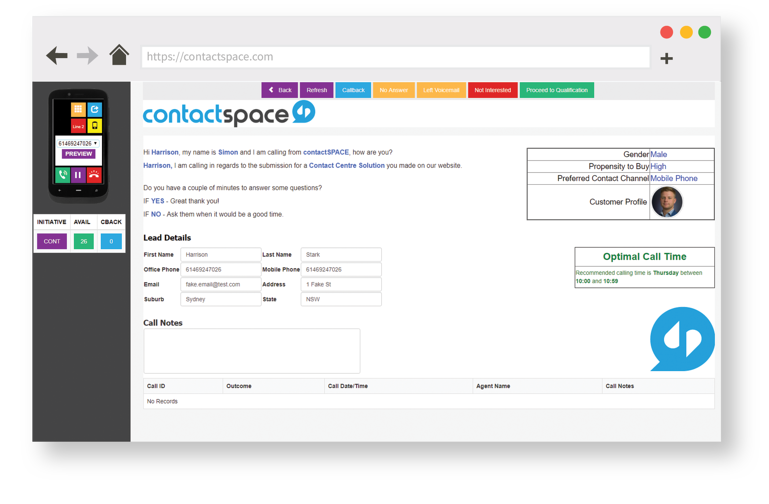Whether you’re calling fresh records for the first time, or attempting to re-engage previous customers, writing scripts for your team to call off is always a difficult task.
The truth is, a lot of organisations get their scripts wrong.
According to Chron, the U.S. Federal Trade Commission receives 18,000 complaints about telemarketing on average each year.
Many of these complaints may be the result of poor dialling strategy design, amongst other reasons. However, when these complaints relate to what is said by the agent, a better script, delivered the right way, is a good strategy to achieve better results.
With the right strategic approach to your scripted material, telemarketing can still be extremely effective. There are multiple reasons for this:
- Immediate response. Despite the rise of digital marketing, telemarketing is still the fastest way to immediately engage a customer. This also means that telemarketing can deliver an immediate return on investment.
- Supporting other marketing strategies. Your inside sales team can directly survey your customers to uncover their perceptions of your products, and to uncover demographic/psychographic information. This information can be used to improve your overall marketing strategy.
- Human interaction. In the age of chatbots and auto-replies, there is a considerable number of consumers who still prefer human interaction. Having a one-on-one call can often be a great way to improve the customer experience.
With these benefits in mind, how can you approach your customers or leads in a way that will actually make them want to listen to what you have to say?
Here are a few cognitive psychology concepts you should be aware of when creating call centre scripts.
1. Choice paralysis

“Would you like a free trial, a free version of the product, or a week-long discount?”
We bet that after asking this question, you’ll probably hear a few seconds of silence, and this can be a good thing. Silence can mean that you have successfully engaged your prospect in a conversation by inviting them to think over the choices that you’ve offered.
However, if too many choices are offered, this can cause stress, leading to hesitation.
This concept in cognitive psychology is called choice paralysis. Multiple studies published by the Harvard Business Review have shown that when a customer has too many options to pick from, they feel “paralysed” when trying to make a decision.
According to one of the studies, when customers have too many choices, their level of satisfaction quickly decreases. The marginal benefit of each additional choice falls off quicker than you might expect.
So, it can be worth giving the customer a series of choices during the conversation – but don’t provide too many options.
When mapping the choices you offer, instead of using a scattergun approach, try to think about the choices that the specific customer might be interested in.
For example, if you have three tiers of products, you could offer the two highest tiers to higher-income customers, and the two cheaper tiers to lower-income individuals.
Here at contactSPACE, we built something called CallGuides® to allow you to do just that.

CallGuides® are essentially an integrated workflow and scripting solution, designed to help call centre agents make better contact.
Each button at the top of the page will load the next segment of your script, or allow the agent to log call outcomes at the end of the call.
Plus, you can define changes to the script based on attributes of the person you’re contacting. In this case, you could display an entirely different script based on income, location, or previous purchasing habits, among other attributes.
2. Instant Gratification

“You’ve been our customer for three years, and as a token of our appreciation, we have $100 gift card for you. Would you like to collect it immediately?”
Who wouldn’t want that?
This cognitive psychology concept is called instant gratification, and is often used in call center scripting.
A study published by Marketing Profs found that only 26% of customers would wait longer than 30 minutes for their takeaway order. This is a real world example of instant gratification in action – customers just never have time to wait.
What does instant gratification imply for the call centre?
Consumers are now able to access almost any product or service near-instantly, exactly when they want it. In today’s competitive landscape, it can be worth offering something of value that’s available immediately.
In inside sales, instant gratification can be used as a technique to increase the perceived value of what you offer to the customer.
What can you offer that will immediately help the person you’re dialing?
Remember, when somebody buys something, they’re committing not just their money to the transaction, but also their time. How long does it take to set up your product, or for it to become fully-functional?
If it can take quite a while, think about what else you can offer to immediately help the customer. For example, a free trial, or one-on-one help to get them started using your product.
3. The IKEA Effect

“Good afternoon, Claire! We’re calling our customers to collect their opinion about possible improvements to our product. Since you’ve been our customer for a long time, can I ask you some questions about how we can make our product better?”
To develop a better customer experience, it’s worth considering the IKEA effect.
This is a cognitive psychology concept which states that consumers place a higher value on products that they feel that they have contributed to creating.
It doesn’t always have to do with a direct change made to a product. A customer might feel more appreciated if they can contribute an opinion or an idea to a company that they regularly buy from. The key is to ensure that the customer knows that you will actually take their feedback on board.
In inside sales, it’s worth remembering that you’re not always going to be able to get a sale immediately. Don’t dismiss objections as mere hurdles you have to jump over – along with customer feedback, they can be a valuable way to find out exactly what your customer wants.
4. Ambiguity Effect

For this one, it’s hard to give any particular example. It’s more about how you structure your call script.
Sometimes, in telemarketing, it’s easy to make the mistake of encouraging a customer down a certain path when they make choices about what to buy. This might seem like the best way to maximise the value attributable to each call, but it could be sabotaging your sales efforts.
Customers usually pick the route that seems the most familiar to them – avoiding anything that feels unusual. This is called the ambiguity effect – a cognitive bias that makes people shy away from something they feel that they lack knowledge about.
Your task here is to structure your call script so as to make the interaction as informative as possible, if you plan on offering something new.
There’s a balance to achieve though – this effect can also occur if you overload your customer with too much information. Focus more on their expectations and viable results that you can prove.
Here are a few ways to benefit from the ambiguity effect:
- Use a metaphor. The metaphor here implies comparing something well-known to the customer with something they don’t know. This way, you’ll show that the option you’re offering is not that different from what your customer is used to, thus, making them feel more comfortable about the concept.
- Employ statistics. We already mentioned above that factual information can convince the customer. So, if you have relevant data , statistics, or even case studies – share them!
- Guarantee a positive outcome. “If you’re not completely satisfied, we offer a 100% money-back guarantee.” A phrase like this adds confidence, as it eliminates risk. The risk of loss is the reason why the ambiguity effect occurs, so by guaranteeing a positive outcome, you can reassure your customer that they have control of the situation.
Make sure that you use all these tricks to represent your brand’s values the best way possible. Remember that marketing calls also work to define your brand’s identity, so it’s best to err on the side of being gentle, not pushy, when interacting with current or potential customers.
5. Confirmation Bias

“You told me earlier that your fitness is extremely important to you, is that correct?”
Take a look at the sentence above. It invites the prospect to reaffirm something that they already believe, that is, it employs confirmation bias to invite a customer into the conversation.
Confirmation bias is a cognitive psychology concept that implies that a person will jump to the conclusion that is in line with what they already believe to be true.
If you’ve ever made sales calls, you’ll know how impossible it is to change someone’s mind about something that they strongly believe. Instead, try to play into what they already believe to be true.
Using this bias in a call script deals mainly with how you formulate your questions. So, in this case, tag questions are recommended, where you declare something “you like the colour blue” and then add an interrogative clause “is that right?”.
“You told me” or a variation of this is often the most powerful tag question, especially in a longer sales cycle, where a lot of back-and-forth discussion occurs. This is because it can be used to anchor to specific needs that the customer has, that you can address.
However, when the sale is made on the first couple of calls, you need to do preliminary research on what your customers might think about your product. Data from customer support and submitted customer feedback can be a great place to start.
Here at contactSPACE, we help our customers personalise their messaging by integrating key customer data in a way that’s easily-usable for agents. You can populate the CallGuide with key customer information, including their name, age, and previous purchasing history.
If you use tag questions, be prepared for what you’ll do if the customer disagrees with what you said. This can be a valuable opportunity to show that you care about what they have to say.
The Human Psyche is an Extraordinary Thing
Isn’t it, really?
Widely used in marketing, cognitive psychology concepts help companies understand their customers better and drive more successful outcomes on-call.
In the same way, you can employ cognitive psychology tricks to create scripts that bring you the result you want.
Author Bio:
Estelle Liotard is a professional copywriter, blogger and content marketing specialist at Subjecto and IsAccurate. Writing was her passion since childhood and became her hobby at school and university, where she worked for the college newspaper. In her free time, she enjoys taking care of her two dogs and volunteering for her local homeless shelter.
